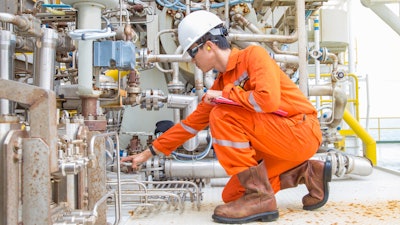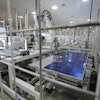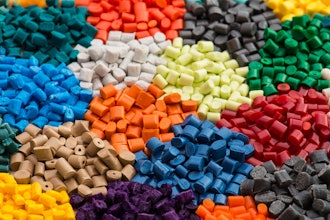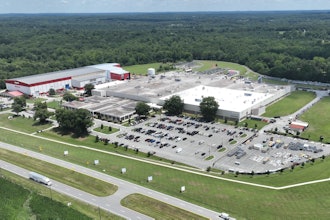
Representing nearly a quarter of the global energy mix, natural gas plays an important role in meeting worldwide energy needs.
Throughout the natural gas supply chain, gas producers require accurate real-time measurement of the composition of liquid natural gas (LNG) for in-process sampling or during transport for custody transfer.
LNG is comprised of methane with heavier components such as ethane, propane, butane and trace elements such as sulfur compounds and aromatics.
As such, data on the composition and concentration of the elements in the mixture can enable producers to increase process understanding and efficiency, improve quality and establish the value of the product.
The need for real-time measurement begins when natural gas is converted into liquid form using one or more compressor trains for liquefaction and purification. Rundown lines then transfer LNG streams to storage tanks.
By measuring the composition in the rundown, LNG producers better understand the product that is going into their tanks. This data enables them to predict how the LNG will age and better plan shipments by pipeline, train and rail.
Although there are established techniques used for this type of measurement, these systems typically require samples to be extracted for testing, with results delayed for 20 minutes or longer.
As a result, Raman spectroscopy is quickly gaining traction as an efficient, reliable and economical alternative that can produce accurate, real-time results.
Raman spectroscopy
Since its discovery in the 1920s, Raman spectroscopy has revolutionized process analysis with its nondestructive mode of operation and capability to measure sample composition.
Raman spectroscopy is a laser-based optical analysis technique used to measure compositions through the vibrational properties of molecules.
For many years, however, Raman equipment had the reputation for being expensive, cumbersome and difficult to use.
Now, advancements in the stability and portability of solid-state Raman systems and technological improvements in lasers, optics and detectors have made the technique faster and more accessible for real-time inline analysis.
As a result, Raman is now increasingly being used as a powerful measurement solution for LNG composition and concentration. When applied to inline processes, Raman spectroscopy can provide results in seconds.
“Raman in the analysis of LNG composition is an important development,” said Martin Mendez, lead research and development engineer at Analytical Solutions and Products B.V. (ASaP), an Amsterdam-based system integrator of LNG analysis and sampling measurement systems used around the world. “The use of Raman spectroscopy for LNG analysis is relatively new and it has already proven to be a highly accurate, efficient and usable compositional measurement tool.”
Samples are collected using a 785nm excitation laser and a contact BallProbe that produces a unique spectral fingerprint that identifies the chemical composition and molecular structure in the LNG.
 MarqMetrix’s BallProbe is available in Hastelloy C-276 - a nickel molybdenum-chromium superalloy to withstand extreme physical and chemical environments.MarqMetrix
MarqMetrix’s BallProbe is available in Hastelloy C-276 - a nickel molybdenum-chromium superalloy to withstand extreme physical and chemical environments.MarqMetrix
The distribution of the spectral peaks describes the molecule’s composition, while the signal intensity correlates linearly with concentration.
For easy-to-use commercial Raman spectroscopy instrumentation, ASaP works with Seattle-based MarqMetrix. Founded in 2012 by scientists from the University of Washington, the company specializes in compositional analysis utilizing Raman spectroscopy and has pioneered advancements in Raman for use in the energy sector.
MarqMetrix has engineered it’s All in One (AIO) system to produce identical and repeatable results from unit to unit, in a package 80% smaller than previous Raman instruments.
Each device is nearly an exact copy so common mathematical models can be applied across systems to produce consistent results.
Previous Raman systems were less reliable because each system required its own mathematical model and frequent recalibration for each installation.
The AIO system works with a wide array of contact probes suitable for LNG applications. The company’s BallProbe is available in Hastelloy C-276 - a nickel molybdenum-chromium superalloy to withstand extreme physical and chemical environments.
 The AIO system works with a wide array of contact probes suitable for LNG applications.
The AIO system works with a wide array of contact probes suitable for LNG applications.
The probe’s spherical sapphire lens can effectively withstand direct contact with the sample even in extreme cold and hot environments (-160°-350° Celsius), high pressure (> 400 bar) and harsh corrosive conditions.
“We work with MarqMetrix because they have a high-quality Raman instrument,” said Mendez. “The company’s immersion optic probes, which are widely used throughout the industry, enable users to achieve reproducible measurements of samples better than 1% accuracy.”
Another significant advantage of Raman spectroscopy is not having to take gas samples offline for measurement. Traditional techniques like GC require an injection system to add a sample gas to a chromatography column that allows the components to separate and a detector to sense when a component is existing the system.
But first, the LNG must be converted from liquid to gaseous state without partial vaporization before a reliable measurement can be made.
With a Raman system, no consumables are required for testing. “The contact probe is placed directly into the LNG without having to manipulate the gas, take if offline or introduce a carrier gas,” said Mendez. “With fewer steps involved in measurement, the uncertainty is reduced hence the measuring is much closer to the truth.”
Raman’s direct measurement of LNG produces readings every few seconds as compared to every 3-5 minutes or longer for traditional techniques.
“You want the real-time information, whenever possible,” added Mendez. “When it comes to a custody transfer, for example, it is ideal to take many representative samples throughout the entire offloading process to a tanker or ship as possible.”
Calibration and predictive modeling
Although the MarqMetrix Raman equipment can be used to identify the components in LNG within approximately 15 minutes of unboxing, quantifying the concentrations of each component first requires creating a predictive model.
To do this, ASaP establishes the accuracy of the Raman equipment at one of its three analytical testing facilities by comparing it against measurements produced by traditional GC equipment, with LNG supplied from a nearby filling station.
“We utilize certified GC testing instruments to produce a reference value that we know will be as close to the actual value as possible,” explained Mendez. “We then take a measurement using the Raman equipment and compare the two (correlate the two measurements to build the model). The next step is to calibrate the Raman with a liquified primary gas standard.
 Each device is nearly an exact copy so common mathematical models can be applied across systems.MarqMetrix
Each device is nearly an exact copy so common mathematical models can be applied across systems.MarqMetrix
“We take a number of samples of LNG at different component concentrations and with the help of multivariate analysis we can create our predictive model,” added Mendez. “Once the model has been validated, ASaP clients no longer need to use GC and can use Raman exclusively for instantaneous readings of the LNG composition.
Accurate measurement is nowhere more essential than ever in the LNG industry. Understanding the chemical composition of raw materials and the consistency of processed products.
With the advancements made in applying Raman spectroscopy systems to sample measurement, LNG producers have a practical tool for generating accurate real-time compositional measurements for their in-process and in-transit LNG sampling needs.
“With the availability of easy-to-use commercial instrumentation, the threshold to work with Raman spectroscopy has now become approachable and workable for LNG applications,” said Mendez.






















